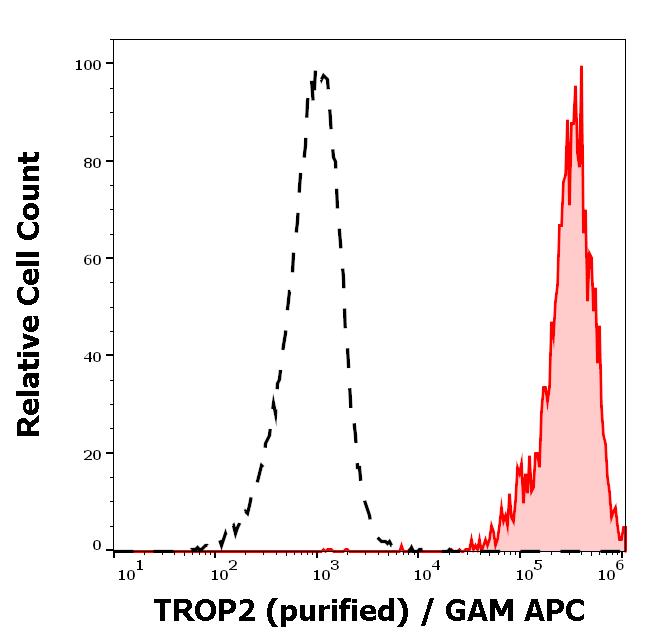Recombinant Mouse Death Receptor 6/DR6/TNFRSF21/CD358 (C-Fc-6His)(Discontinued)
Shipping Info:
For estimated delivery dates, please contact us at [email protected]
| Amount : | 50 µg |
| Content : | Lyophilized from a 0.2 µm filtered solution of PBS,pH7.4. |
| Storage condition : | Lyophilized protein should be stored at -20°C, though stable at room temperature for 3 weeks. Reconstituted protein solution can be stored at 4-7°C for 2-7 days. Aliquots of reconstituted samples are stable at -20°C for 3 months. |
| AA sequence : | QPEQKTLSLPGTYRHVDRTTGQVLTCDKCPAGTYVSEHCTNMSLRVCSSCPAGTFTRHENGIERCHDCSQPCPWPMIERLPCAALTDRECICPPGMYQSNGTCAPHTVCPVGWGVRKKGTENEDVRCKQCARGTFSDVPSSVMKCKAHTDCLGQNLEVVKPGTKETDNVCGMRLFFSSTNPPSSGTVTFSHPEHMESHDVPSSTYEPQGMNSTDSNSTASVRTKVPSGIEEGTVPDNTSSTSGKEGTNRTLPNPPQVTHQQAPHHRHILKLLPSSMEATGEKSSTAIKAPKRGHPRQNAHKHFDINEHVDDIEGRMDEPKSCDKTHTCPPCPAPELLGGPSVFLFPPKPKDTLMISRTPEVTCVVVDVSHEDPEVKFNWYVDGVEVHNAKTKPREEQYNSTYRVVSVLTVLHQDWLNGKEYKCKVSNKALPAPIEKTISKAKGQPREPQVYTLPPSREEMTKNQVSLTCLVKGFYPSDIAVEWESNGQPENNYKTTPPVLDSDGSFFLYSKLTVDKSRWQQGNVFSCSVMHEALHNHYTQKSLSLSPGKHHHHHH |
Source: Human Cells.
MW :64.7kD.
Recombinant Mouse Death Receptor 6 is produced by our Mammalian expression system and the target gene encoding Gln42-His349 is expressed with a Fc, 6His tag at the C-terminus. Tumor necrosis factor receptor superfamily member 21(DR6) is a single-pass type I membrane protein and contains 1 death domain and 4 TNFR-Cys repeats. The protein may activate NF-kappa-B and promote apoptosis and it may activate JNK and be involved in T-cell differentiation.It is required for both normal cell body death and axonal pruning. Trophic-factor deprivation triggers the cleavage of surface APP by beta-secretase to release sAPP-beta which is further cleaved to release an N-terminal fragment of APP (N-APP). N-APP binds TNFRSF21 triggering caspase activation and degeneration of both neuronal cell bodies (via caspase-3) and axons (via caspase-6).
MW :64.7kD.
Recombinant Mouse Death Receptor 6 is produced by our Mammalian expression system and the target gene encoding Gln42-His349 is expressed with a Fc, 6His tag at the C-terminus. Tumor necrosis factor receptor superfamily member 21(DR6) is a single-pass type I membrane protein and contains 1 death domain and 4 TNFR-Cys repeats. The protein may activate NF-kappa-B and promote apoptosis and it may activate JNK and be involved in T-cell differentiation.It is required for both normal cell body death and axonal pruning. Trophic-factor deprivation triggers the cleavage of surface APP by beta-secretase to release sAPP-beta which is further cleaved to release an N-terminal fragment of APP (N-APP). N-APP binds TNFRSF21 triggering caspase activation and degeneration of both neuronal cell bodies (via caspase-3) and axons (via caspase-6).
Always centrifuge tubes before opening. Do not mix by vortex or pipetting. It is not recommended to reconstitute to a concentration less than 100 µg/ml. Dissolve the lyophilized protein in ddH2O. Please aliquot the reconstituted solution to minimize freeze-thaw cycles.
Endotoxin : Less than 0.1 ng/µg (1 IEU/µg) as determined by LAL test.
For Research Use Only. Not for use in diagnostic/therapeutics procedures.
| Subcellular location: | Cell membrane |
| Tissue Specificity: | Detected in spleen B-cells (at protein level). Ubiquitous. Highly expressed in adult spleen, thymus, testis, prostate, ovary, small intestine, colon, brain, lung and kidney, and in fetal brain, liver and lung. Detected at lower levels in adult peripheral blood leukocytes, lung, and in fetal muscle, heart, kidney, small intestine and skin. Detected in T-cells, B-cells and monocytes. In T-cells expression is highest in Th0 cells, intermediate in Th2 cells and lower in Th1 cells. Expressed at low levels in proliferating progenitors in the spinal cord, but is highly expressed by differentiating neurons within the spinal cord and adjacent dorsal root ganglia. Expressed by developing neurons as they differentiate and enter a pro-apoptotic state. Expressed by both cell bodies and axons. |
|
There are currently no product reviews
|



















.png)









